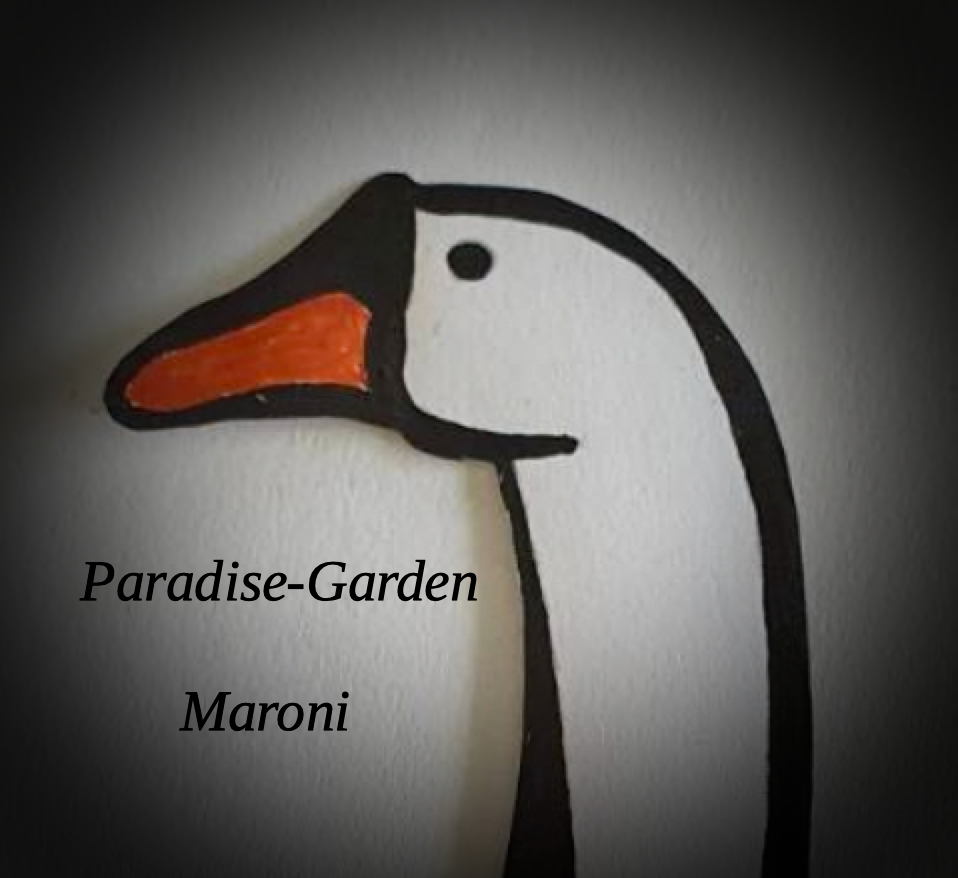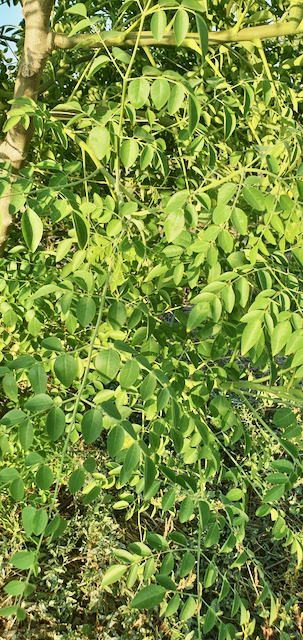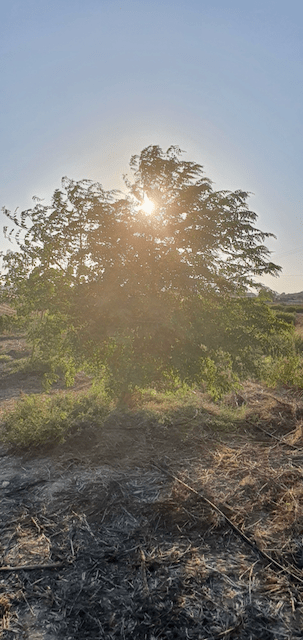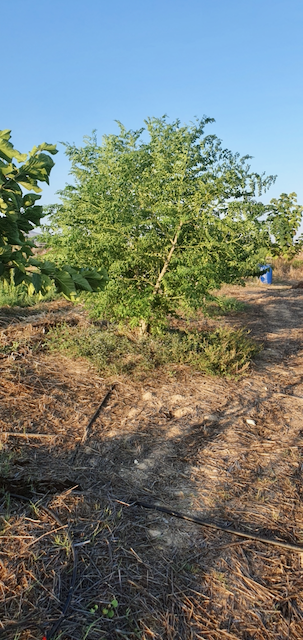Der afrikanische Moringa, eine Bombe. Diese Kraft, diese Ausstrahlung und diese Blätter. Ich bin ganz hin und weg. Wer hätte das gedacht, und das nach zwei Jahren mit einmal beinahe abfrieren, absägen und neu aufbauen.
Beinahe täglich holen wir Zweige mit Blättern, trocknen, versorgen uns und die Hühner damit – und er wird immer größer. Genial, oder?
Der afrikanische Wunderbaum, der Meerrettich Baum. Er versorgt den Menschen mit allen benötigten Mineralien und Vitaminen, ein Vollversorger.
Warum ist er Superfood, Heilerpflanze? Eben, Nahrung als Medizin, Medizin als Nahrung. Weil er alles in sich hat was der Mensch benötigt.
Und wenn der Mensch hat was er benötigt, wie soll er krank werden?
Wir sind so glücklich und überlegen, ob wir nicht eine ganze Plantage anlegen sollen, da wir noch so viel Platz haben und wahrscheinlich einen beträchtlichen Teil des in Zypern gewünschten Mornigas abzudecken.
Und vielleicht fallen uns noch Rezepte ein, die neben der bombastischen Energie auch noch besonders gute Gaumenfreuden bereiten.
Die Welt ist voller Wunder, wenn der Mensch Eins mit der Natur ist und sich als Teil der Natur sieht, was er ja auch ist. Erwin Thoma, der Baumflüsterer sagt darum auch Mitwelt und nicht Umwelt – oder vielleicht beides!?
Moringa Stenopetala – the African Miracle Tree
https://discover.hubpages.com/living/moringastenopetala
The African Moringa Tree
In Africa, the Moringa Stenopetala tree is often called “Mother’s Helper”. Why do they call it that?
Good question. Is it because it cuts a woman’s housework in half? No, that’s ridiculous. Is it because helps to keep track of her children? I don’t think so. Is it because she can safely use its limbs to “rock-a-bye” babies? Now, really…
Moringa Stenopetala has rightly earned the title of “Mother’s Helper”, because eating its leaves greatly increases a nursing mother’s milk supply – and adding Moringa to her meals, helps combat malnutrition in her offspring. Most people who are familiar with Moringa, have only been exposed to the Moringa Oleifera variety. Both of them are excellent sources of nutrients, as are all varieties of Moringa, and they are also extremely environmentally-friendly.
The uses of the Moringa Stenopetala tree are almost endless, as it supplies a leafy green, edible flower buds and blossoms, edible seed pods, seeds that can be effectively used to purify water, and branches that make excellent mulch. That is just a sampling of the uses of Moringa Stenopetala, and there are many, many more.
Unfortunately, in cold climates, African Moringa trees cannot be grown outdoors successfully. Fortunately, they can be grown successfully in a greenhouse. If you live in a cold climate, but have access to a greenhouse – get some seeds, and start growing! There are some excellent sources of seeds available, and the seeds germinate quickly, sometimes within a week from the time they are planted. That’s pretty fast – for a tree!
The Moringa Stenopetala seeds on the left are still in their husks, or shells. Those on the right side are husked or shelled.
Moringa Stenopetala seeds
So very different from Moringa Oleifera seeds
This is what African Moringa seeds look like.
Some of them in the photo are still in their husks, some are de-husked. The seeds on the right side, are de-husked. They look like blanched almonds, but have a soft, velvety feel to them. The seeds on the left side, are still in their husks. For planting purposes, it really doesn’t make a difference. Either way, their germination rate is exception, unlike the Moringa Oleifera – and husked, or unhusked – they all grow rapidly
For their size, they are very lightweight. When you consider that they are the beginning of an immense tree, their seeds appear to be very small – usually between ¾” and 1¾” long. With Moringa trees, those relatively small seeds rapidly grow into huge trees. Avocado pits, or seeds, are giants by comparison – yet the Moringa seeds grow faster, and usually larger, than Avocado trees do. Herein lies one of the exquisite mysteries of our world; how the smallest seed – like a mustard seed, can grow into one of the largest trees on earth.

Moringa Oleifera seeds. They are quite different from Moringa Stenopetala seeds.
Moringa Oleifera seeds
Still Moringa, but a different variety
These seeds are from the Moringa Oleifera tree.
Short, brown, chubby, and winged – they don’t look ANYTHING like the Moringa Stenopetala seeds, but they are still Moringa seeds. Isn’t it odd, how very different the seeds are? Yet, they grow into the very same type of tree – a Moringa tree – in the plant family Moringaceae.
Moringa, and its many unique properties, never ceases to amaze me. Moringa trees are able to survive a drought – which makes them very valuable in many places in Africa, where drought is an ever-present danger. Technically, Moringa trees are not supposed to survive freezing weather – ours have! The rule of thumb, with Moringa Oleifera at any rate, is that you should not expect flowers or seed pods – “drumsticks” – until the tree is at least 8 months old. We have had them, consistently, on 6 month old trees. They are not supposed to like any salt in the soil. Well, forget that! We plant them very close to a large body of saltwater, in Florida, and – they thrive! Our theory, is that they must know we love Moringa, because nothing else – makes sense…
“Stan” the Moringa Stenopetala Seed
Moringa in Agriculture and Fodder for Livestock
By the way, did you know that Moringa Stenopetala, and all varieties of Moringa, are excellent fodder for chickens, pigs, cattle, and other types of livestock? You did not? Well, now you do!
Moringa Stenopetala leaves – in morning dew
These make good eating!
Our “meaty” Moringa Stenopetala leaves…
They weren’t on the tree very long, because I stripped them off of their branches, and ate them. In my opinion, they just “can’t be beat”, for ease of stripping enough of them off to make a meal, and their exotic “nutty-leaf” taste!
One thing we love about Moringa Stenopetala, is that it cooks fast and keeps its bright green color – unlike many leafy greens.
The raw leaves provide an walloping dose of Vitamin C that puts oranges to shame. Even when cooked, the Vitamin A in Moringa leaves of any variety puts spinach to shame, the calcium is usable – unusual in the plant kingdom, the protein content is high, and the nutritional list just goes on and on. A few minutes spent in harvesting Moringa Stenopetala’s large leaves, can provide enough greens to feed – and nourish – a large family!




Recent Comments